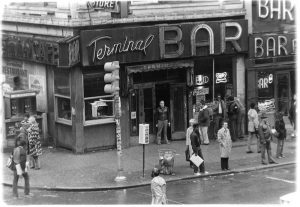‘Terminal Bar’ is a short film, directed by Stefan Nadelman. Initially it seems like a relatively self evident documentary, however, it is actually an account of events from Stefan’s fathers perspective, through the eye of a lens.
The structure of the film is made up of still photographs, taken by Stefan’s father Shelly Nadelman between 1972 and 1982. These stills act as “a photographic record of New York’s most notorious watering hole” (Terminal Bar, 2002), whilst also providing a social narrative. They not only document the human backstory and personality of every customer who entered the ‘Terminal Bar’ over the decade, but also reveal a very personal account of Shelly’s critical observations on society at this time.
The stills are interrupted throughout by traditional filming, which causes a kinetic juxtaposition between real time and portraits, past and present, black and white and still and motion. Nadelman achieves this by using two frames in one shot, which helps to show the contrasting themes. Alongside this, narrative and newspaper text work in conjunction with each other, which documents the narrative through text and voice.
Later on in the film, a break in the narrative is replaced by music, which creates a kaleidoscopic effect. The kinetic vibrancy of the music at this point is caused by the syncopated visuals which appear in time with the music. The images mimic the beats on screen and this not only makes the film musical to hear but also to look at.
When revisiting the ‘Terminal Bar’, Shelly Nadelman said “If I didn’t document it, nobody would ever know…nothing has changed” (Terminal Bar, 2002). He took time to document it, and his son Stefan took time to document his fathers work through the art of film. I can take inspiration from this by documenting great design and narrating my own design process as I work.
Terminal Bar. (2002). [film] New York: Stefan Nadelman.
Image 1- Terminal Bar. (n.d.). [image] Available at: https://twitter.com/aflashbak/status/772457058188787712 [Accessed 2 Dec. 2017].

